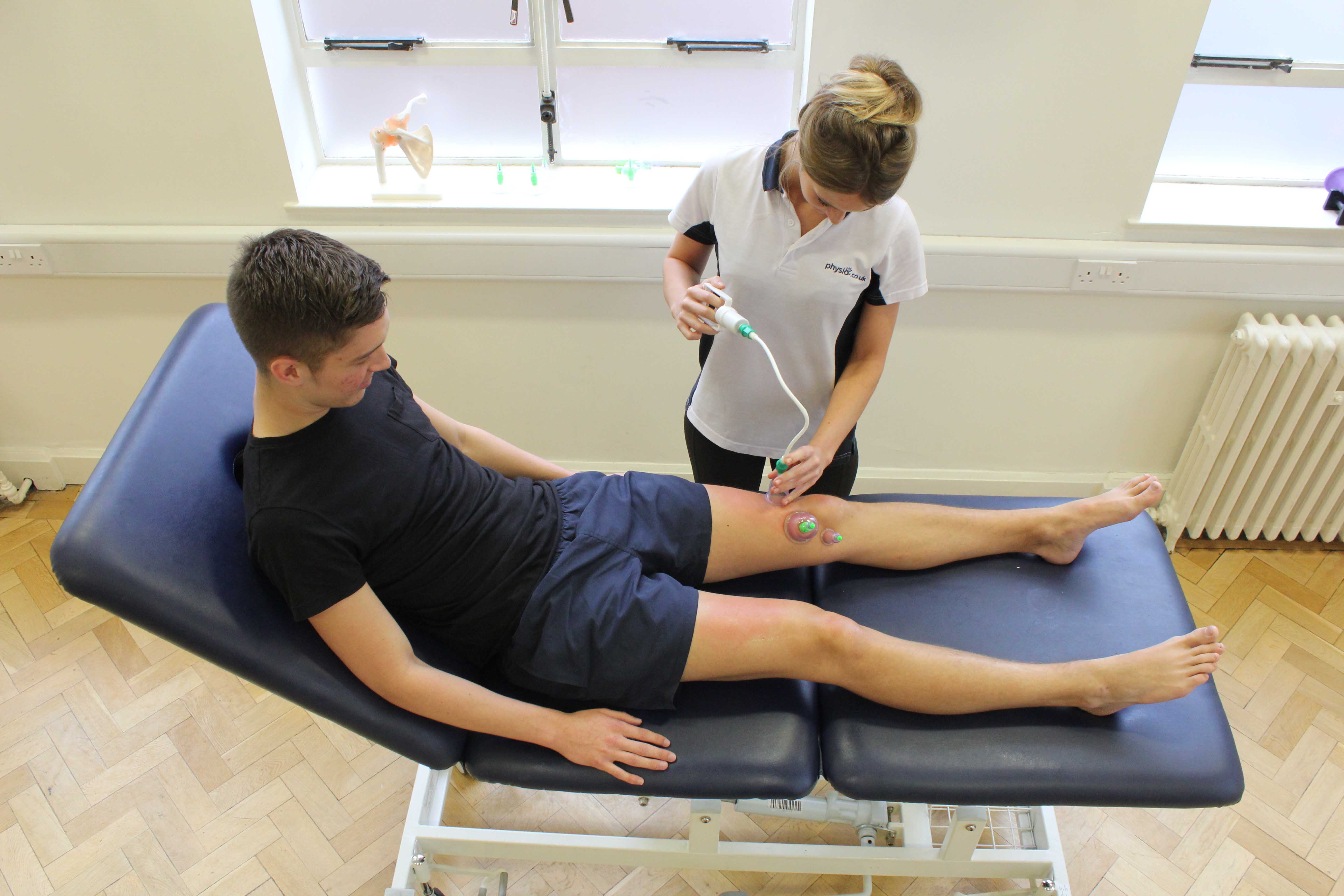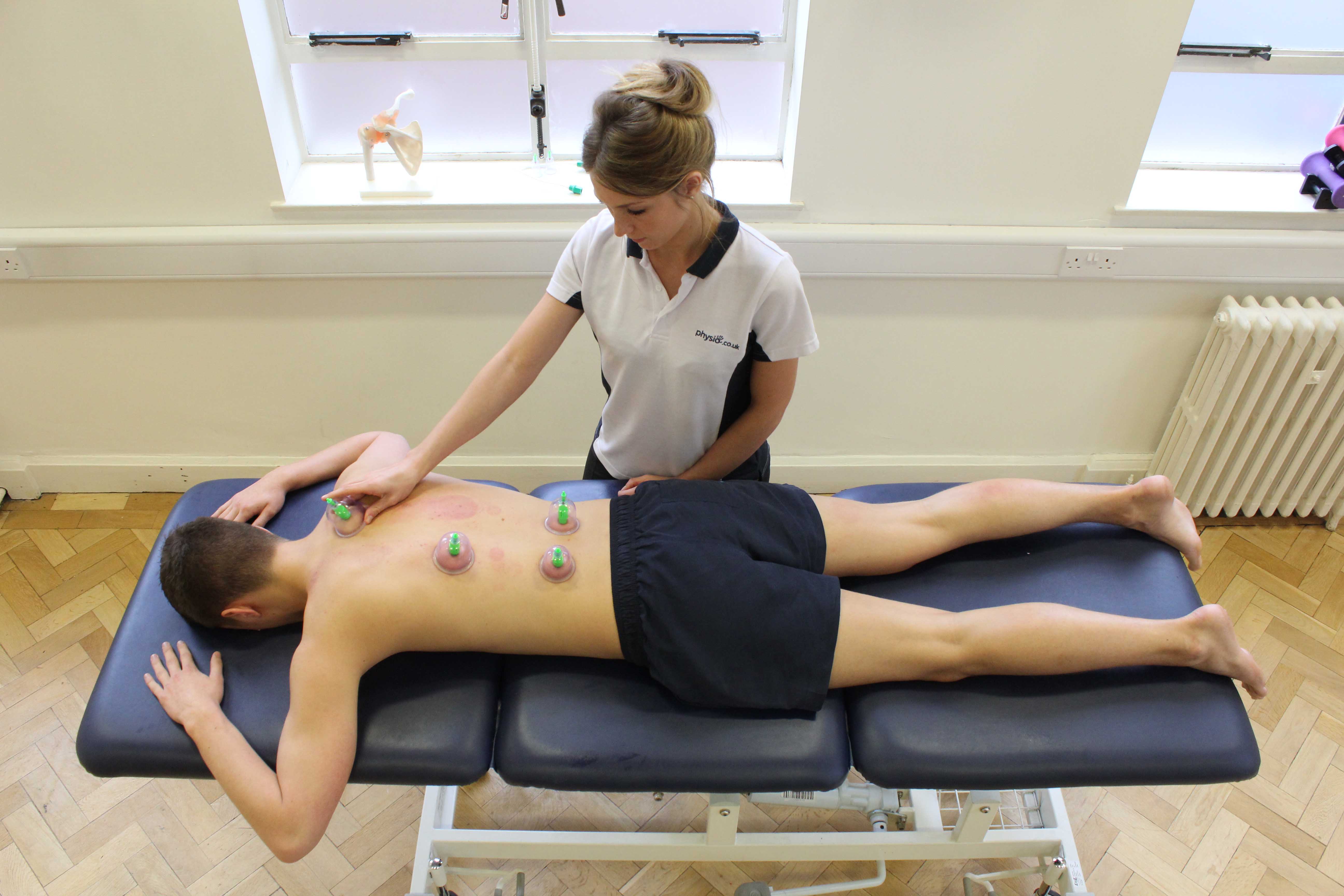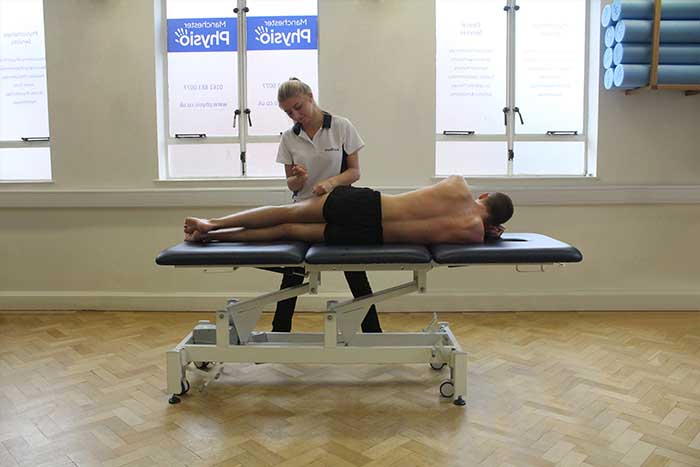Cupping is a massage technique in which local suction is created on the skin using plastic cups. Hand cups can be used on any region of the body. Cupping increases blood circulation and is effective to release tight muscles, fascia and reduce high tone. Massage therapists at Physio.co.uk can use cupping as an effective massage technique to treat a range of conditions
What is cupping?
Cupping is a vacuum type massage technique performed with handheld cups. Placing suction cups on the body creates a partial vacuum to reduce tension on the skin and tissues underneath. By creating suction and vacuum pressure, it can soften tight muscles and tone, loosen adhesions and lift up restrictive connective tissues. The specific technique brings hydration and blood flow to the body's tissues. It can be used to move deep inflammation to the skin surface for release and drain excess fluid and toxins by opening lymphatic pathways. Cupping can be used over any region of the body as long as there is a seal between the skin and cup, therefore cupping is more suited to larger areas of muscles.
When is cupping used?
Cupping can be used to help on many circumstances. These circumstances include:
 Above: Cupping massage technique
Above: Cupping massage techniqueCupping can be used after any form of exercise or post sporting events. Cupping is effective to be used after exercise to help remove waste products from the tissues and muscles. During exercise, acids and waste products such as lactic acid are built up. A build-up of waste products can contribute to muscle soreness and tightness. Cupping can help lift up the tissues, increasing blood flow. Increased blood flow can drain out waste products from the tissues and replace them with oxygen and nutrients.

Cupping can be used to treat tight muscles. Cupping is beneficial as it relieves tightness without the need of large pressure being applied. The cupping massage technique lifts the tissues up, relaxing the muscles and allowing the muscle fibres to move slightly apart. To enable the muscle fibres to move apart rather than being tightly packed together increases the range of movement and flexibility of the muscle area.
Cupping is also effective to be used to treat high tone. High muscle tone is the main cause of muscles tightening up. When muscles are tight, tissues become stiff and rigid which limits movement. Cupping releases high tone by increasing temperature of soft tissues, increasing blood circulation, breaking down adhesions and decreasing tone.
What are the physiological effects of cupping?
Massage can produce many important physiological effects on the body. The physiological effects of cupping include:
 Above: Cupping massage technique
Above: Cupping massage techniqueCupping increases temperature of the tissues. Increasing temperature is important to help relax muscles and help decrease tension. Cupping stimulates temperature by increasing blood flow to an area. The vacuum pressure lifts tissues up and can turn the skin red, indicating that circulation has been brought to the surface. Increased blood flow brings more nutrients and oxygen to the tissues.
Cupping also can stimulate the removal of waste products in the tissues. During an increase of blood flow, waste products and toxins are removed. The removal of waste products can lead to healthier muscles and prevent tension build up.
Cupping can produce relaxation and decrease cortisol in the body. Cortisol is a stress hormone. When cortisol is released from the brain, emotions of stress and anxiety can be felt. Cupping increases temperature and sedates the nervous system. Stimulating the nervous system decreases the feeling of stress and is replaced by emotions of calmness.

What are the benefits of cupping?
Cupping has many benefits. The benefits of cupping include:
Cupping is beneficial to decrease tension within the tissues. Tension can be produced by stress, surgery and repetitive exercise. Tension can produce tightness and begin to restrict movements around joints. Cupping can be used to release tension by lifting tissues up and draining out any build-up of waste products.
Larger cups can be used to relieve tight muscles. Larger cups can produce a stronger vacuum and mimic the techniques of a deep tissue massage. Movement of the cups along the muscles can stimulate the removal of knots and areas of rigid tissues. Tense muscles are softened quickly by the increase of temperature and blood circulation. Cupping is also very effective to release restrictions in fascia and scar tissue within muscles.
Cupping is an effective technique to increase blood flow around an area. Increased local blood supply to the muscles and skin delivers nourishment and allows toxins to be carried away via the lymphatic system. The lymphatic system can drain away and flush out waste products and toxins from the body. Pain can be relieved due to improved circulation and discomfort is relieved and tense muscles are softened.
Cupping can also produce a relaxing effect. Cupping can sedate the nervous system and often a deep state of relaxation is produced. A therapeutic effect is beneficial to those with high blood pressure, anxiety, fatigue. Alongside relaxation, the effects of cupping can also increase temperature and produce a tingling sensation.
Common body parts treated by cupping
There are many common body parts that can be treated with cupping. Common body parts treated by cupping are:
Cupping can also be performed on other areas of the body and be effective to relieve soft tissues and improve circulation.
Summary
Cupping is an effective massage technique to reduce tension and decrease pain. Handheld cups are placed on the surface of the skin in which a suction technique is used to lift the skin and tissues up. Cupping increases the blood flow and can remove waste products out of the body. Cupping can be used over any region of the body as long as there is a seal between the skin and cup. Cupping is more suited to larger areas of muscles. Massage therapists at Manchester Physio can use cupping as an effective treatment for a range of conditions.
How can I arrange a cupping massage treatment?
The easiest way to arrange a cupping treatment at Physio.co.uk is to email us at office@physio.co.uk or call us on 0800 033 7800.

 0330 088 7800
0330 088 7800



































